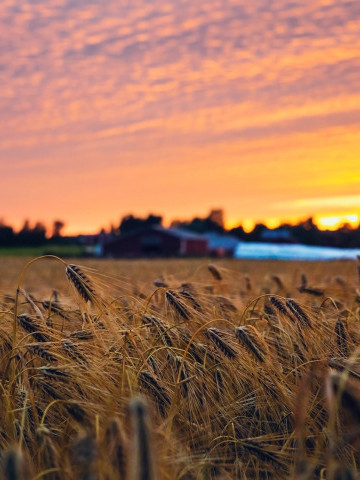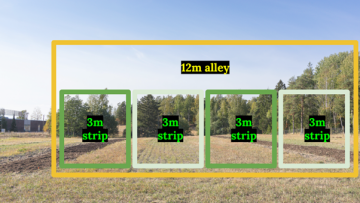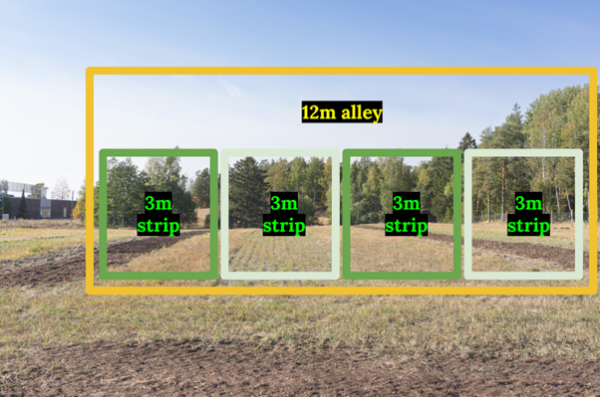
Bioekonomi
I bloggen Bioekonomi får du veta mer om Yrkeshögskolan Novias forsknings-, utvecklings- och innovationsverksamhet inom forskningsområdet systemomställning för att bygga resiliens. Majoriteten av personalen finns huvudsakligen i Raseborg. Här bildar forskare, projektarbetare, lärare, studerande och administrativ personal en dynamisk helhet. På vår blogg kan du läsa om vilka vi är, vad vi gör och om våra resultat. Välkommen!
Vid frågor eller feedback kontakta bloggens administratör Heidi Barman-Geust (Heidi.barman-geust(a)novia.fi)
Vi följer CC BY 4.0 om inget annat nämns.
Systemic Transformation to Build Resilience is one of Novia University of Applied Sciences six' research areas. The activity is mostly located in Raseborg, in southern Finland. As a dynamic unity, our researchers, project workers, teachers, students and administrative personnel produce versatile results in research, development and innovation. We blog about who we are, what we do, what our conclusions are, and how we implement them. Welcome!
If you have questions, please contact Heidi Barman (Heidi.barman-geust(a)novia.fi)
We folllow CC BY 4.0 if nothing else is stated.
Successional Agroforestry? Part 2

Welcome back to Part 2 of “Reaching Agroforestry’s Full Potential with Successional Agroforestry.” This installment will cover the second and third suggestion from the study on how to make that happen. If you missed the first installment, you can find it at this https://novialia.novia.fi/novialia/bloggar/bioekonomi/reaching-agroforestrys-full-potential-with-successional-agroforestry. Part 3 will consider the Value Proposition outlined in Part 1 of this series and bring the series of blogs to a close.
Suggestion Two: Use Precision Farming Techniques to Optimize Nutrient Inputs
❖ “Second, the introduction of tree rows in agroforestry causes spatial and temporal variations of not only nutrient inputs from leaf litter and root turnover but also of light and evapotranspiration, which cause spatial variability in yield. Using this knowledge, precision farming techniques have the potential to further optimize nutrient inputs both in space and time. At present, fertilizer is applied using standard farm equipment in our studied cropland agroforestry and open cropland systems, which leads to uniformly high nutrient input even in areas closest to the tree rows with low yields.” (Veldcamp, et al. page 6)
You might be thinking that I did not thoroughly answer the last question I posed myself in the section above: So how will we adapt fertilization rates to a field that has zero local yield, low biological activity, and low nitrogen availability?
I wanted to leave that question unanswered so that I could continue the discussion along the lines of the second suggestion to “optimize nutrient inputs in space and time.”
When applying nutrients and other inputs it is important to have quality information to base the application program on. Quality information includes not just the state of the soil, but also farmer observations of the system, current growth stage, as well as in field variation. In field variation of nutrient availability is a characteristic of agroforestry systems. As the study pointed out, there were very clear differences in yield depending on the proximity to tree systems. The authors inclusion of sunlight and water in this discussion is laudable since the quantity and quality of both of these resources have major implications for nutrient dynamics. This is especially true of systems like ours.
How will our system address the varying distribution of resources created by agroforestry?
We address the problem on two associated levels:
Design
Established perennial plants, whether they are woody or not, have a competitive advantage over annuals grown adjacent to them.* Whether this is because of their extensive root systems or expansive canopies (or both), we can take measures to alleviate these challenges during the design phase.
*Management of perennials through carefully timed pruning can alleviate some of this competitive advantage, but I am unaware of scientific research investigating specific usage of this method
Let’s look at designing for root zone competition first. At Lill-Nägels, we do not intend to create a closed canopy agroforestry system. If we were, then competition between the roots of the perennial species in the agroforestry rows and the alleys would be a moot point as swift utilization of the alleys by the perennials is actually a goal. Instead, we want the alleys to remain as viable habitat for full-sun loving annual species as long as possible. Therefore something needs to be done to prevent the perennials from colonizing our alleys.
I will diverge into management here simply to keep the treatment of root pruning in one place. Root pruning may not always be an effective management strategy to deal with the competition issue, but it has proven effective in many instances, hence its widespread use. We plan to use a tractor pulling a sharp shank, essentially a subsoiler, to a depth of say 20-30 cm along the edge of the tree beds. This will prevent the trees from developing perennial roots in the alleys.
There is no way, short of constructing a physical barrier, to entirely prevent the trees from putting new roots into the alleys, but we can still keep the trees from developing large perennial roots. Logic would have it that, similarly to when cutting branches, pruning of large roots could more easily lead to infection than pruning small, young roots. Root pruning, then, needs to be done regularly to prevent the trees from investing in large roots in the alleys in the first place. Performed in the spring, this action could be closely timed to synchronize with planting the alleys.
So what does this have to do with design? The relationship is simple: if we know that we want to prevent the trees from growing perennial roots in the alleys- while also understanding the need for trees to have access to topsoil to build their soil ecosystems- then using root pruning as a management technique has implications for how wide to make the tree lines (or beds). If we were to combine root pruning with narrow tree lines, the total volume of topsoil available for the perennials to develop their root systems could prove too small for the needs of the tree. Deep roots are important, but we should not lead ourselves to believe that they can replace the dynamism present in topsoil with its advantage in air exchange (among others). To conclude with root pruning, we have designed the beds to be two meters wide. We posit that this should provide sufficient topsoil for the trees if we manage the whole system for healthy, deep topsoil development. There are a number of other reasons that I delve into in the design documentation of our project (Lill-Nägels ‘Site Design’, n.d.).
Now let’s look at how design influences the distribution of light in the system. Each species of tree has its own architecture, growth habits, and therefore creates a unique pattern of shade (which can change over time and with context). I will not pretend to have a systemic understanding of these characteristics of each plant, but I feel it is something that will strongly inform second or third generation successional agroforestry systems in our climate. At Lill-Nägels, we are taking a simpler approach to reducing the amount of light intercepted by trees: increasing the distance between our canopy and emergent strata species “in row” and decreasing their overall height. In order to reduce the lost photosynthesis potential from excluding taller trees from the system, the deliberate filling of the lower strata niches becomes quite important.
We have planned to mostly use semi-dwarfing rootstock while increasing the distance between individuals of the same strata. This will ensure that the system reduces shading in the alleys. Trees kept to about three meters in height may not even be considered to be “trees,” in any common sense of the word, but they produce viable crops and the pedestrian orchard approach improves ergonomics and safety. Eliminating the need for ladders comes with a tradeoff in potential production, but a “pedestrian” tree system has its own advantages in our specific context.
Our system also includes thousands of individuals from “non-productive” tree species such as oak, ash, maple, willow, and poplar. These are obviously plants that can grow 20, even 30 meters tall in our part of the world. These will be managed in such a way that the vast majority of them are cut out of the system before they can overposition, or, “take” light from our target cash crops. Those that remain will be managed as coppice or pollards, spaced sufficiently, at least 12-15m between specimens, to reduce total shading in the alleys.
Taken together, these two design decisions should reduce the negative impact on the alleys caused by the inclusion of woody perennial species.
Management
Design alone is not enough to overcome the challenge of unequal resource distribution. Our management of the system needs to be planned beforehand while also deploying adaptive strategies to address problems.
The first thing we need to do in this case is undertake sufficient monitoring, both direct & indirect, of the system. Direct monitoring of the nutrient profiles of the soil and plant sap will allow us to build up a record over time of nutrient availability and scarcity. By monitoring the tree lines and alleys separately, we may begin to reveal differences between these two areas which are under different systems (annual versus perennial). Sap analysis, conducted throughout the growing season, will alert us to measurable changes in plant nutrition and provide actionable information.
Indirect monitoring, on the other hand, relies upon proxy indicators of nutrient levels. A proxy indicator of nutrient levels can be anything from variations in plant color, growth rate, texture, or even pest and disease pressure. Regular observation by the farmer explains the old adage regarding their footsteps as being the best fertilizer.
In addition to in-field monitoring, the use of satellite imagery- which also does not measure the nutrients inside the plants directly- can be used to help guide decision making provided that the spatial resolution of the instruments can resolve the difference between alleys and tree systems.
Why would we want to emphasize the indirect monitoring of the system’s health by recording observations of plants? Because we cannot send every last thing worth measuring off to the laboratory for testing. Farmers need to be able to correlate what the laboratory says is happening with the samples they can afford to send with what they see happening in the field. Very few measurements of a system should be taken as a stand in for understanding the greater whole. Even more so than in monoculture systems, polycultural systems need to be evaluated in context because the number of relationships is so large.
Taken together, these two kinds of information can inform the decision making process used to determine whether or not to intervene as well as how. Using all the information at hand to inform the composition, application rates, and spatial distribution of foliar applications of nutrients can help us use resources more effectively.
Suggestion Three: Diversify Crops in Space and Time
❖ “Third, agroforestry may be further optimized by diversifying crops: (a) inclusion of shade-tolerant crops in the rotations as tree height increases with age, and (b) growing shade-tolerant crops near the tree rows in combination with light-demanding crops in the common rotations.” (Veldcamp, et al. page 6)
Of the three suggestions, this is perhaps the most relevant to the novel planting patterns used at Lill-Nägels. Nutrient management is something every farmer could probably do better with. However, even farmers keen on reducing over fertilization by more precisely applying nutrients may find the suggestion to diversify in space and time a bit radical, or at the very least, too impractical. Adding complexity to farming systems is, like most things, easier said than done. But it is something that we have taken up with our pilot project for precisely the reasons suggested here.
Both parts of this suggestion rest upon the observation that these systems have open or underutilized niches available. The suggestion to make use of the shady niche created once these systems get taller makes plenty of sense from an ecological perspective. Our design goes a few steps further and tries to fill as many of the niches as possible from project initiation through to maturity of the tree crops. We have, however, intentionally kept the diversity of crop species we use to fill those niches low to simplify management.
The first part of this idea the authors have, “(a) inclusion of shade-tolerant crops in the rotations as tree height increases with age,” has already been conceptualized in successional agroforestry: stratification. In our project, we are drawing inspiration from the work done with Syntropic Agriculture to use four different strata (categories) for the layers present in the system: emergent, canopy, medium, and low. Stratification in this school of thought refers not merely to the mature size of a species, but more specifically to the light requirements of the plant at different stages of its life cycle.
At Lill-Nägels, the fruit trees (pears, plums, apples, and cherries) will eventually form the open canopy of the system. With semi dwarfing rootstocks and modern training techniques, plenty of light will still filter through their canopy towards the floor of the system. We plan to use rhubarb, a semi-shade tolerant cash crop and mulch producer, to intercept that light under the canopy.
Between the widely spaced canopy species we will have other semi shade-tolerant species such as currants. The amount of sun is still likely to be close to full if we only take into consideration the cash crops, but when we stop to consider the biomass/support trees, which act as nurse crops, there will likely be more variation in the shade patterns than the crop plan suggests.
An important word above is eventually: it will take time for the trees to fill that role and, in the meantime, the “canopy” strata would be empty unless we choose to fill it. So our design also calls for other species of faster growing annuals- and even perennials- to occupy that particular strata. Those other species will begin filtering sunlight in those higher strata in service of improving the soil for the eventual succession to a fruit tree canopy. Our system lies somewhere in the middle of the potential complexity of a successional agroforestry system: it is by no means as advanced as these systems can be.
That said, how to incorporate stratification into an economically viable system in our socioeconomic context of Northern Europe is a tougher question than recognizing and filling underutilized niches in space and time.
Now let’s turn to the second part of the suggestion: “(b) growing shade tolerant crops near the tree rows in combination with light-demanding crops in the common rotations.” Figuring out how to do this is a lot more straightforward than stratifying space and time in the tree systems themselves. We’ve designed the alleys at Lill-Nägels to be twelve meters wide. This width corresponds neatly with the three meter width of the planter commonly used on the farm and the widest implement we plan to use, a 12 m sprayer for applying foliar nutrients and biostimulants. Taken together, this means we can employ strip cropping in a few different patterns with the resulting 4 x 3 m strips. Our narrow alleys (perhaps as narrow as one can reasonably go if you want an open canopy system) will not provide enough strips to have a true tolerance gradient to the changes in the local environment created by the trees.

Four strips do, however, offer the opportunity to trial this idea as the system matures by planting shade tolerant crops adjacent to the tree rows and leaving the middle two strips open for more sun loving crops. We are confident that the wide spacing and short trees of our system should make the need to do this irrelevant, but the opportunity is there.
This third topic is very interesting and one could address the appeal of stratification in successional agroforestry systems at much greater length, but that would be for another time.
Thank you for reading Part 2 of this blog series! The third and final part will be posted on 8.5.2023.
Texten har granskats av Novias campusredaktion och publicerats 27.4.2023.
![]()
Bioekonomi
Blogginlägg som är granskat av Novias redaktionsråd är utmärkta med nyckelordet "Granskat inlägg".
Vi följer CC-BY 4.0 om inget annat nämns.
Ansvarsfriskrivning: Författaren/författarna ansvarar för för fakta, möjlig utebliven information och innehållets korrekthet i bloggen. Texterna har genomgått en granskning, men de åsikter som uttrycks är författarens egna och återspeglar inte nödvändigtvis Yrkeshögskolan Novias ståndpunkter.
Disclaimer: The author(s) are responsible for the facts, any possible omissions, and the accuracy of the content in the blog.The texts have undergone a review, however, the opinions expressed are those of the author and do not necessarily reflect the views of Novia University of Applied Sciences.